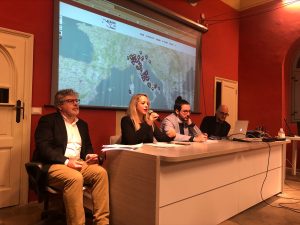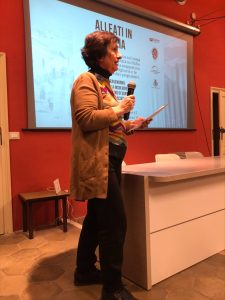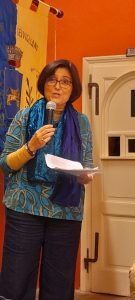Pictured Above : Costantino Di Sante, Isabella Insolvibile, Nicola` Cacciatore and Igor Pizzirusso
Research into the history of prisoner of war camps in Italy during the second world war took a huge step forward on 19th November 2022 with the presentation of a new website created by Istituto Nazionale Ferrucio Parri, with support from the Monte San Martino Trust (MSMT).
Entitled Alleati in Italia (Allies in Italy) the first stage of this dual-language website contains existing and new research into 70 prisoner of war camps in Italy that were used to intern 76,000 Allied servicemen captured in North Africa. The site also has an interactive map and 40 profiles of PoWs, drawing in part on records in the National Archives at Kew (London) and on PoW memoirs posted on MSMT’s online archive. The site’s scope allows for the eventual analysis of all aspects of the Allies’ presence.
Casa della Memoria, Servigliano
The presentation of the website, which can be accessed at www.alleatiinitalia.it, took place at Casa della Memoria in Servigliano (Le Marche), the site of PG59 which housed Austrian PoWs in the first world war and Allied servicemen in the second conflict. The camp is now officially a site of national interest.
In a video message to the gathering, Paolo Pezzino, director of the Parri institute, said that the website was the fruit of a collaboration with MSMT aimed at presenting a complete picture of PoW camps. He congratulated the researchers on their work and thanked MSMT for their contribution, which included a financial one.
Rossella Ruggeri, of MSMT
The event itself was introduced by Giordano Viozzi, of Casa della Memoria, who outlined plans to partly restore PG59 and press on with its educational programme. After the introduction of representatives of local organisations and Sara Zanisi, Parri’s general manager, Rossella Ruggeri spoke on behalf of the Monte San Martino Trust.
Unique Relationship
Referring to the “strange alliance” that bound escaping PoWs and the thousands of brave Italians who hid them, she said that MSMT, in addition to its study bursaries for young Italians, had recently heightened its focus on research. “Parri’s offer to create a website concentrating on the Allied presence from 1939-1947 was therefore a great opportunity for MSMT. It’s undoubtedly an enormous subject and the variety of often unpublished material makes it a complex undertaking. However, the Parri institute, thanks to its extensive network of historical institutes throughout Italy is certainly in the best position to question, select and collate existing and new sources.”
Sara Zanisi then introduced a discussion panel that comprised leading historians of Italy’s anti-fascist Resistance movement. This consisted of Costantino Di Sante, Isabella Insolvibile, Nicola` Cacciatore and Igor Pizzirusso, a digital historian and Parri’s IT expert.
As the researchers explained, much was already known about what happened after the Armistice with Italy in September 1943 but little about the camps and the relationship between prisoners and local citizens. Their work focused on trying to answer such questions. In profiles of the PoWs the use of a narrative style and photos was aimed at engaging with the general reader, not only academics. On the website the camps and the stories are linked.
Sara Zanisi
The website is live and more material will be added. As Sara Zanisi pointed out, its scope is the entire Allied presence in wartime Italy. It will cover not only the PoWs but other aspects including helpers among the civilian population. The next phase of the website is being planned.



